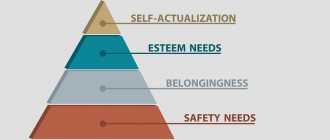Common questions
By asking, we want to receive information that confirms our vision of the world, our perception of the situation, our “map of the world.”
If someone does something that seems very strange to us, we immediately ask, “Why are you doing that? What's gotten into you? And he will be forced to justify himself and explain himself. Because we want to understand him! We want to understand what he did, but in our coordinate system. Because we limit the questions we ask to 15% of their total variety.
Let's talk today about the remaining 85%, which we usually don't touch. And also about questionology - the art and science of asking questions.
Common Mistakes
Let's also go over the most common mistakes people make when asking something.
- Ask a question that contains a ready answer
People often make this mistake when they are unsure of something and want outside confirmation. Such questions are not only meaningless, they are also harmful. By asking them, a person reveals self-doubt and unwillingness to rely on oneself.
Examples:
- Does this blouse suit me?
- Do you agree that this is the best offer?
- I think we should postpone the trip, don't you think so too?
In all these options, a person tries to shift part of the responsibility for making a decision onto the interlocutor. Moreover, the opinion of the person himself is not taken into account; he is told in plain text what he must answer. Many people are annoyed by such navigating. If you really want an unbiased view of the problem, ask differently.
- Put pressure on your interlocutor
Questions can also be a way of putting pressure on the interlocutor. I strongly advise against using them for this purpose. You will lose the person's trust and lose the chance to get the information you need.
Examples:
- Why the hell haven't you washed the dishes yet?
- Do you think it's okay to talk to me like that?
- Is it okay that I've been waiting for you for 10 minutes?
It is better to express your indignation with an affirmative sentence. It's more constructive.
- Asking a new question without waiting for an answer to the previous one
By doing so, you risk being left without important answers. A person cannot keep several questions in mind at once. Most likely, he will answer only the last one. You will either have to repeat it several times, or be content with incomplete information.
- Feign understanding
If you don’t understand something in your interlocutor’s answer, don’t hesitate to ask again or clarify certain points. An unclear answer is useless; you will never be able to apply it in life. Moreover, the person will assume that you understand him and expect an appropriate reaction.
Don't be afraid to seem stupid and irritate your interlocutor by asking again. On the contrary, he will note your responsible attitude to his words and will be imbued with respect.
Socratic technique
There is a technique that allows you to expand questions.
The first who long ago understood the need to change traditional questions was Socrates. For example, if one of his students complained about injustice, Socrates did not ask him: “Why are you complaining about injustice?” Recognize that answering this question will not advance the debate much. Socrates asked: “What assumption have you made to conclude from it that this is unjust?”
See how the focus is shifting? This time the student thinks about how his own inferences function. By asking this question, Socrates allows us to think about his way of thinking, that is, reflecting. And on top of that, he asked the student to determine what his “world map” consists of.
The purpose of Socrates' questions is to make the student think, teaching him a lesson through it. A brilliant idea, I must say.
How to create a poll in a conversation
Starting a vote in a conversation is no different from the sequence of actions that we looked at earlier. Only the poll section is enabled through the “paperclip” icon and here you cannot select the type of voting and the time of its publication.
Go to messenger, select chat and create a survey.
Example showing how to include a poll section in a conversation
Next, fill out all the parameters, click the arrow button and publish the survey in the conversation.
Poll settings in a conversation
Below is an example of a published vote in a conversation.
Example of a posted poll in a conversation
Aristotle's Lyceum
Aristotle, another philosopher, went even further. He built the first lyceum in Athens on this principle: asking questions to make you think - this was the principle of the learning process there.
What is the situation with lyceums in the 21st century? Questions are used in abundance. But only in order to evaluate the student, who must reproduce everything that was told to him. He is asked one question and expected one specific answer. Which is also known in advance! In fact, this should be called interrogation. To teach and then question - this is the essence of a modern lyceum. A huge difference from the Socratic project. But we were taught that way too.
Why ask questions at all?
We ask questions to find out what is happening around us, but not in order to learn something fundamentally new - to only confirm and strengthen the already existing “map of the world.”
You can say that the system works well - why ask any other questions? Einstein said this: “If I have 1 hour to solve a problem on which my life depends, I will spend the first 55 minutes searching for the best question I can ask myself. When I find it, it will take me 5 minutes to answer it correctly.”
How to ask to get a “Yes” answer
Human psychology will reveal this secret to us.
First of all, do not use negative particles in your expression. These include “no” and “cannot”. This formulation provokes a person to refuse, because you yourself suggest how to answer. Sometimes it is easier to refuse if there is no particular desire to agree or fulfill your request.
To obtain consent, you need to formulate the question in an affirmative, positive form.
For example, instead of “Will you marry me?”, you need to ask “Will you marry me?”
"Question everything"
This message is also great because it shows how a genius carries out his research. It is more about questioning than seeking answers. If he had asked himself the traditional question beginning with the word “why” (“Why are the movements of celestial bodies not explained by modern theories?”), he would not have advanced physics as much as he did. Instead, he most likely asked the Socratic question: “What modern hypotheses can be proposed to explain the celestial movements?” That is, the revolutionary nature of his contribution lies in the fact that he proposed to change existing hypotheses. He suggested that time and space are impermanent. A revolutionary idea that changes the “map of the world” in physics. As you can see, asking questions is very important.
Coaching Example
To better understand how questionology works, I propose to consider the example of coaching a teenager.
Teenager: “I work very hard, participate in class, stay attentive, do all my homework, spend a lot of time on it. But as soon as I find myself on a test, everything disappears from my mind, it’s like I’m in a stupor.”
You see, this teenager is already extremely active. He is the actor in his situation. He works, he listens to explanations in class, he participates in the lesson, he looks for answers when he is called on.
If I ask the question: “Why do you get stuck on a test?” - it won't help him. Because he is already the main character in it, and I will ask him to remain in this role.
Instead, I will suggest that he change his position. I suggest you first feel what is happening. And then step back from the situation and observe from the outside what he is doing.
Coach: “When you get stuck on a test, how do you feel?”
Teenager: “I have a great fear of failing a test. And this prevents me from moving on."
Coach: “What are you afraid of when you’re afraid of failing a test?”
Teenager: “Well, if I get bad grades, I think it will prevent me from choosing what I want to do in life later.”
Do you see? A simple change of position regarding the object of the question allows this teenager to become aware of his “map of the world.” And the question that forces you to step away from the situation is not as difficult to formulate as it seems. It is enough to repeat the verb twice: “What are you afraid of when you are afraid of a test?” And the teenager suddenly realizes that for him the point of the test is to ultimately be able to choose a career.
You can practice detaching yourself from the object of any question by repeating the verb. And it works every time.
When we have realized what our “world map” looks like in a particular place, we can offer various other possibilities, new directions.
To do this, you need to offer other mental gestures.
Until this moment, he used the description of what was happening to him. I will offer him a mental gesture, which consists of bringing two different elements together.
Coach: “Does this mean that a bad grade on a test will prevent you from choosing a profession later?”
Teenager (after some thought): “Well, actually, no. Just because of one test, I won’t have any problems choosing a career direction.”
After this mental gesture, I offered him another one. It will put him in an interesting situation.
Coach: “Okay. If you don't write a test, what's the worst thing that will happen to you?”
Teenager: “I’ll have to rewrite it and be more careful.”
As you can see, by offering him different mental gestures and positions, we multiply the possibilities, whatever the subject of the question.
How to make a survey on VK from your phone
It’s just as easy to create a vote from your phone as from your computer. Let's look at how to create a survey on your personal page.
Go to your profile and start creating a new post. Click on the three dots and find the survey section.
Example showing how to find the survey section in a new post from a mobile phone
In the open window you will see the same functionality as on a PC.
Example of how survey settings are displayed on a mobile phone
After filling out the basic parameters, click on the checkmark. A poll window will open where you can add additional content, select the type of voting, time and topic.
An example of how you can make a survey from a mobile phone









